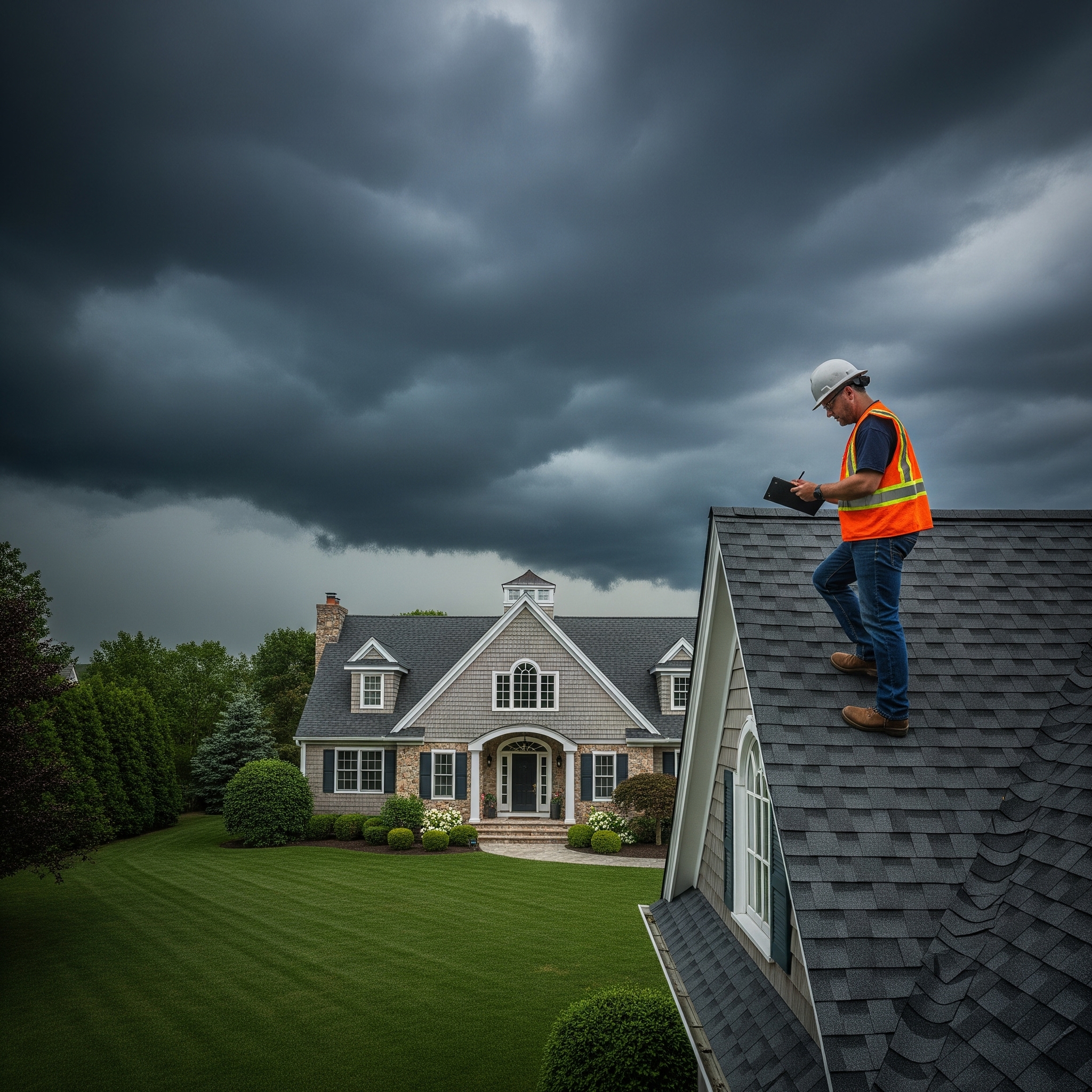Storm damage roof inspection:Storms can strike quickly, leaving behind hidden roof damage that worsens over time. Whether it’s high winds, heavy rain, hail, or snow, Long Island homes are exposed to a range of severe weather threats throughout the year.
At Baba Roofing, we specialize in storm damage inspections, emergency repairs, and long-term roofing solutions that protect your home. In this guide, we’ll explore how storms impact roofing systems, the most common signs of damage, and the steps you should take immediately after a storm passes.Storm damage roof inspection:
Long Island’s Stormy Weather: What Your Roof Faces
Living in Nassau or Suffolk County, you’re no stranger to:
-
Nor’easters in winter
-
Thunderstorms and high winds in spring
-
Hurricane threats in late summer
-
Heavy rainfall and ice buildup in fall and winter
Each weather event puts your roof under different stress conditions. Without regular inspections and fast repairs, even a small breach can lead to water damage, mold, and costly structural repairs.
Storm damage roof inspection:
Types of Storm Damage to Watch For
1. Wind Damage
High winds can lift, loosen, or completely tear off shingles — especially on older roofs. Wind also drives rain underneath shingles and flashing, exposing your home to leaks.
Look for:
-
Missing shingles
-
Lifted or curled shingle edges
-
Debris lodged under roof components
-
Detached flashing around vents and chimneys
2. Rain Damage
Heavy rainfall can exploit any existing weakness in your roof. Even if shingles look intact, water can seep through minor cracks or failed sealants.Storm damage roof inspection:
Look for:
-
Ceiling water stains
-
Damp insulation in the attic
-
Musty smells or mold signs
-
Peeling paint or bubbling drywall
3. Hail Damage
While hail isn’t frequent on Long Island, it does happen — and it can be devastating to roofing materials, especially asphalt shingles.Storm damage roof inspection:
Look for:
-
Dents or bruises on shingles
-
Loss of granules (check your gutters)
-
Cracked or split shingles
-
Damaged skylights or roof vents
4. Snow and Ice Damage
Snow accumulation and ice dams create pressure and water intrusion risks. As snow melts, poor ventilation and clogged gutters can cause ice to refreeze and back up under shingles.Storm damage roof inspection:
Look for:
-
Ice ridges near eaves
-
Leaks during snowmelt
-
Sagging areas from heavy snow load
-
Icicles forming around gutters
What to Do After a Storm
If your area has just been hit by a major weather event, take the following steps:
1. Inspect Your Roof From the Ground
Walk around your property and visually check for missing shingles, fallen branches, loose gutters, or flashing debris. Use binoculars if needed — never climb up yourself if conditions are unsafe.
2. Check Inside the Home
Look for water stains on ceilings, bubbling paint, or any signs of new leaks in the attic. Use a flashlight to inspect hidden areas.Storm damage roof inspection:
3. Take Photos
Document any visible damage for your insurance claim. Capture wide shots and close-ups. Don’t move or alter anything yet.Storm damage roof inspection:
4. Call a Trusted Local Roofer
Contact Baba Roofing right away for a storm damage roof inspection. We’ll respond quickly, identify all problem areas, and provide a complete report you can share with your insurance company.Storm damage roof inspection:
📞 Call now: <a href=”tel:+16315526884″>(631) 552-6884</a>
🔗 Or request a free estimate online
The Importance of a Professional Storm Inspection
Storm damage isn’t always visible. Some of the most expensive roof issues develop over time due to hidden weaknesses left untreated.
At Baba Roofing, our inspection includes:
-
Shingle integrity and placement
-
Flashing and sealant review
-
Gutter and downspout inspection
-
Roof structure evaluation from the attic
-
Moisture detection in insulation or decking
We’ll give you a full written report, photo documentation, and an honest assessment of what needs to be fixed or monitored.
Storm damage roof inspection
Does Home Insurance Cover Storm Damage?
In many cases, yes — but there are important details:
-
Damage must be sudden and storm-related (not due to neglect)
-
You must file a claim promptly, often within days of the event
-
Your insurance adjuster may require third-party inspection documentation
We’ve helped dozens of Long Island homeowners navigate insurance claims. Ask us about our insurance support services — we can coordinate with your adjuster and provide all the necessary documentation.
Prevent Future Storm Damage
You can’t control the weather, but you can prepare your roof:
-
Schedule annual inspections (spring and fall)
-
Keep gutters and downspouts clear
-
Trim overhanging branches
-
Replace aging shingles before storm season
-
Upgrade flashing and sealants
-
Install proper attic ventilation to prevent ice dams
Ask about impact-resistant shingles or storm-resistant roof systems if you’re replacing your roof.
Why Long Island Trusts Baba Roofing
-
Family-owned and locally operated
-
Emergency service available after storms
-
Fully licensed and insured
-
Insurance documentation support
-
Free inspections and detailed repair estimates
-
Top-rated across Nassau and Suffolk County
Get Storm-Ready with Baba Roofing
Don’t wait until the next storm causes major roof damage. Be proactive, schedule your inspection, and get peace of mind from a team that knows your neighborhood.
📞 Call Baba Roofing at (631) 552-6884
🔗 Book a free estimate or storm inspection now
Baba Roofing – Protecting Long Island Homes Before, During, and After the Storm
